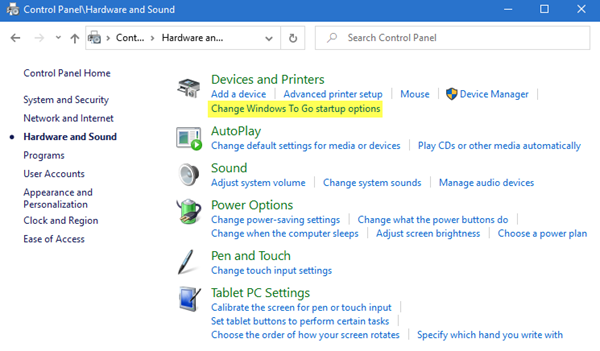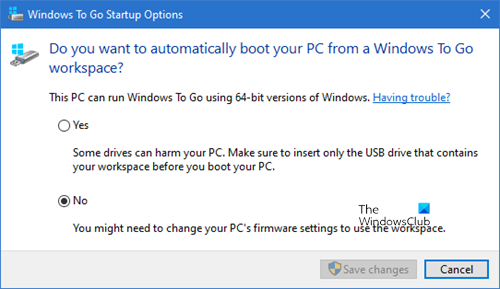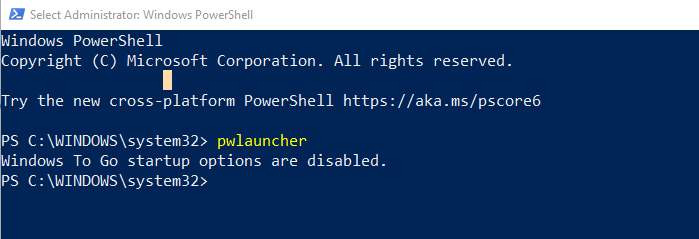When a business or education wants to offer people to work from anywhere, but at the same time also want to make sure that the data is not compromised, they can use Windows to Go workspace feature. In simple words, this feature allows the OS to be copied to a USB device, such as a flash drive or a portable hard drive. In this post, we will share how you can change Windows To Go Startup Options.
Change Windows To Go Startup Options
Windows To Go is like carrying Windows 10 on the USB stick. You can connect to any computer, and boot from the device. Windows will automatically make sure that all resource is available to its disposal.
- Windows Control Panel
- Turn Windows To Go on or off from Command Prompt
- Configure Windows To Go via Registry
- Use Group Policy Editor to enable or disable Windows To Go settings
If you ever wonder – Can I run Windows 10 from a USB Drive – then this is your answer.
1] Windows Control Panel
Follow these steps to change the startup options

- Open the classic Control Panel
- Go to Hardware and Sound > Device and Printers
- Click on Change Windows To Go startup options
- It will open a pop-up window where you have two options. These options are to enable and disable i.e., If you want to boot your PC from a Windows to Go workspace automatically
- Yes—When you choose this, make sure insert only the USB device that contains your workspace before you boot your PC
- No—If you are disabling, then make sure to change the boot sequence in PCs’ firmware, i.e., BIOS or UEFI.

You can also invoke this pop-up by typing the following command in the Run prompt
rundll32.exe pwlauncher.dll,ShowPortableWorkspaceLauncherConfigurationUX?
If you prompted by a UAC, then click on Yes.
2] Turn Windows To Go on or off from PowerShell

You can run pwlauncher command with these options to turn on or off. It’s is a command-line tool to configure the computer to boot into a Windows To Go workspace automatically. If you use this tool, you do not need to enter your firmware or change your startup options
pwlauncher /disable or pwlauncher /enable
If you simply run pwlauncher, then it will disable the status.
3] Configure Windows To Go via Registry
If you want to change this on multiple computers, use this method. Once done on one computer, you can export the registry changes, and import them to other computers.
Open Registry Editor
Navigate to:
HKEY_LOCAL_MACHINE\SOFTWARE\Policies\Microsoft\PortableOperatingSystem
Change keyword for DWORD with name Launcher to 1 (Disable) or 0 (Enable).
4] Use Group Policy Editor to enable or disable Windows To Go settings
- Open Group Policy Editor (gpedit.msc in the Run Prompt)
- Navigate to Computer Configuration > Administrative Templates > Windows Components > Portable Operating System.
- Change to disabled or enabled
Windows to Go FAQ
What is the difference between standard Windows installation and Windows To Go?
- All internal disks of the computer are offline
- Trusted Platform Module is not used
- Hibernate is disabled by default
- Windows Recovery Environment is not available as it is not required
- Similarly, there is no option to Refresh or Reset Windows To Go
- You cannot Upgrade Windows To Go installation
How do I stop Windows from going to Windows To Go
You can follow any of the above methods, Control Panel, Registry, Group Policy, and PowerShell to Windows does not boot into Windows To Go.
Which editions can use Windows To Go?
- Windows Enterprise
- Windows Education
Is Windows To GO to is still being developed by Microsoft?
According to the official page in Microsoft Docs, which was updated this year on 31st Jan 2020, Windows To Go is no longer being developed. The primary reason is that there is no way to update Windows and hence causes a problem in the long run. Also, it requires a specific type of USB that is no longer supported by many OEMs.